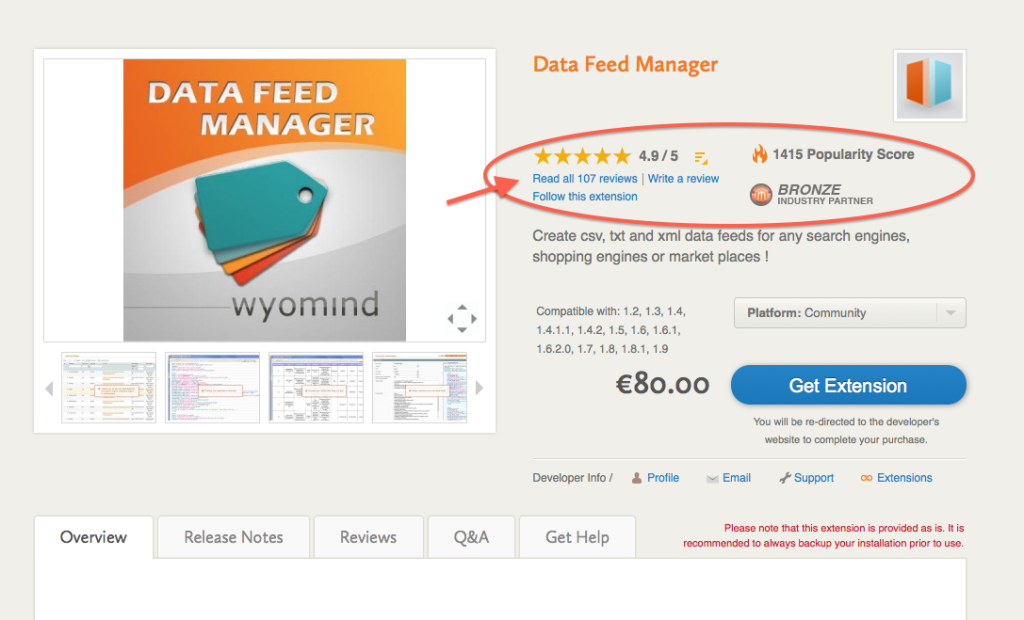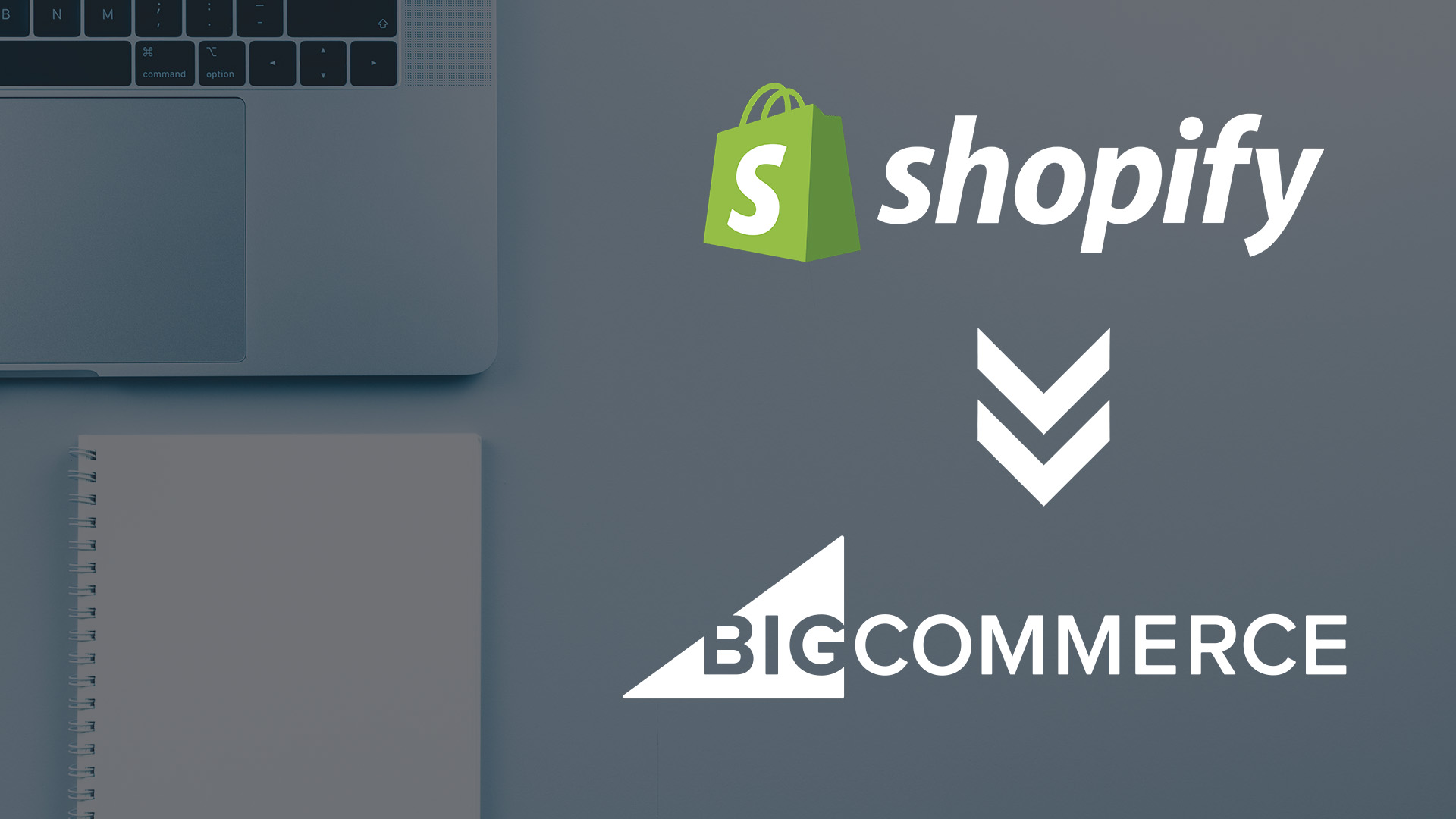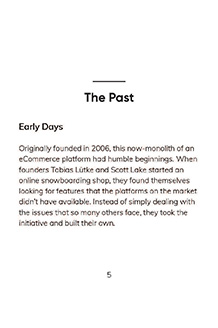Chapter 1:
The Past
The History of Shopify & eCommerce
Early Days
Originally founded in 2006, this now-monolith of an eCommerce platform had humble beginnings. When founders Tobias Lütke and Scott Lake started an online snowboarding shop, they found themselves looking for features that the platforms on the market didn’t have available. Instead of simply dealing with the issues that so many others face, they took the initiative and built their own.
Rapid Growth
Making some of the best decisions among their competitors launched Shopify into the everyday parlance of those who sell products online. After building their own API in 2009, hundreds of unique integrations have been built in order to make growth easy for merchants on Shopify.
Sustaining at Scale
By 2015, Shopify had 120,000 brands selling on their platform. With a constantly growing team of developers, sales executives, and agency partners, it was imperative that Shopify continue to shine without falling flat under the pressures that a rapidly growing business faces.
Chapter 2:
The Present
Where Shopify & eCommerce Are Today
With so many unique eCommerce platforms on the market, why have so many merchants all chosen to host their online stores with Shopify?
Shopify Plans
There are 4 standard offerings that merchants can choose from in regards to Shopify Plans. In the first category are “Basic” for $29/mo, “Shopify” for $79/mo and “Advanced” for $299/mo. Outside of these plans, Shopify’s enterprise solution is referred to as “Shopify Plus,” which starts at $2000/mo. The structured pricing of these plans means that merchants can begin with the plan that applies to their current business operations, and upgrade as more advanced features are needed.
Basic
The “Basic” plan has the highest fees per credit card transaction at 2.9% + 30¢ USD for online purchases. This plan also includes basic reports, only two user accounts, 4 inventory locations, and up to a 77% shipping discount when leveraging an approved shipping provider.
Shopify
This plan is the best value for small to medium-sized eCommerce brands. With a slightly lower transaction fee, 2.6% + 30¢ USD for online purchases, brands retain a higher profit margin from their sales. This plan includes advanced reports, up to 5 user accounts, 5 inventory locations, and up to 88% shipping discounts.
Advanced
The advanced plan offers an even lower transaction fee of 2.4% + 30¢ USD. With a custom report builder, up to 15 accounts, and 8 inventory locations, this plan is best for mid-sized merchants that are experiencing a large amount of growth.
Shopify Plus
Shopify Plus is the highest level offering with enterprise-specific features that smaller merchants wouldn’t benefit from. With multi-storefront and multi-channel selling capabilities, you can list your products in more places than with standard shopify plans. Merchants can also contract with Shopify agency partners such as us here at Groove Commerce for custom development services to solve for a variety of merchant-specific challenges.
Why Shopify
Now that we understand the pricing structure of Shopify’s plans, we can dive deeper into why so many merchants choose this specific platform to host and sell their products on.
Easy To Use Interface
What good is a highly sophisticated eCommerce platform if it is difficult to complete simple tasks in an efficient manner?
The Shopify backend UI is extremely user friendly, but can become complex the further you dig in. Enabling merchants to feel comfortable with their platform of choice is the first step to them using the more detailed features that are available just below the surface.
Drag and Drop Editor
After your products have been added to your new eCommerce store, you may find that you wish to reorganize how some of the content modules on your website are displayed.
With other platforms, this required either an internal resource with a foundational understanding of HTML and CSS development experience or an outside developer. With Shopify, a user with the correct permissions can simply drag and drop new content on the page, or move content to an area that they prefer. This adds to the simplistic UI that Shopify merchants experience.
Integrations
Remember the API that we mentioned earlier? That API is used to create integrations that make the backend operations of eCommerce merchants run more smoothly than the native functionality of Shopify offers. These integrations are referred to as “apps” by Shopify, which can be viewed in their entirety from the Shopify App Store.
PAYMENT PROCESSORS
Aside from Shopify’s internal offering, Shopify Payments, merchants can select from a wide range of payment options. These include the standard options which we are all accustomed to seeing online such as Google Pay, Apple Pay and PayPal.
eCommerce retailers can also choose to offer 3rd party payment plan providers such as Klarna. These options provide the full payment up front to the merchant, while allowing the customer to pay the price of the item over a predetermined amount of time with minimal fees. This is a great option for merchants who sell high-ticket items which customers could not otherwise afford.
SHIPPING
Merchants can use Shopify’s pre-selected providers to take advantage of shipping discounts that come with the plan they have selected. Outside of these options, sellers can use third party apps to manage their shipping operations.
The shipping service you use will need to work seamlessly with the structure of your warehouse and shipping departments. If you have multiple shipping warehouses across your operating territory, ensure that the plan you select will allow for this functionality.
TAXES
Making sure that you are properly tracking sales by location is key to paying the correct amount when reporting to your country’s revenue tracking agency. There are dozens of integrations to choose from, but we have found great success with Alavara.
We recommend assessing your own needs by taking a look at all of the tax tracking integrations available on the Shopify App store.
MARKETING
Shopify does have a number of marketing features built directly into the platform, which you may or may not have access to depending upon the plan that you select. For merchants looking to compete with other online brands, these features are not as capable as third party integrations.
The marketing team here at Groove Commerce leverages Klaviyo for email and SMS communications. With an easy setup process, Klaviyo can send discounts, abandoned cart reminders and more all automatically by referencing synchronized data from your eCommerce store.
Vast User Base
As of July 2022, there are 1.75 million merchants selling on Shopify. What are the benefits of sharing the same platform with so many users?
SUPPORT NETWORK
Shopify’s own forums, Shopify Community, as well as external forums, provide a limitless amount of information for those new to the platform to consume. If you are facing an issue within Shopify, odds are that you are not alone. It is likely that someone else has already asked the question and had it answered by someone more familiar with the platform.
Check out these great websites before throwing in the towel or reaching out to customer support. The fix may be easier than you anticipate!
PARTNER NETWORK
The Shopify Partner Network is made up of hundreds of agencies that can bring your website ideas to life. This partner network can help with anything from branding to custom implementation. No matter what challenge you are facing, there is a Shopify partner to help you achieve your goals.
DOCUMENTATION
The documentation that Shopify provides in their Help Center is industry-leading. This resource typically answers questions with complete support guides to address your challenges head-on. In order to retain merchants, it is imperative that Shopify keeps their documentation completely up to date with the current status of their platform. This is a great first stop when looking for specific answers to questions you have about creating and modifying your online store.
B2C Focused
While other platforms are focused on other verticals such as B2B, Shopify focuses primarily on the business or direct to consumer segment of the market. This means that the lower priced plans do not offer advanced options such as tiered pricing, wholesale pricing, and pricing rules that B2B companies rely on.
This is not always a bad thing - in fact it could be great for your business. With so many online stores in the B2C market, Shopify may provide every single feature you need without hassle. Beware of the exact features that your plan provides. Otherwise, you may spend extra time implementing workarounds that solve for an issue other platforms take care of natively.
Themes
PREBUILT TEMPLATES
Shopify offers a massive amount of professional pre-built templates, which they refer to as themes, for you to choose from. There are cases where these templates will not satisfy your business’s needs - what do you do then?
CUSTOM TEMPLATES
Agencies like ours here at Groove Commerce are the perfect solution for eCommerce businesses with complex challenges that cannot be solved without custom development. Our team of specialized designers and developers can bring your ideas to life. Check out some examples of the great custom development work we have done in the recent past!
Forms
Forms are a primary way that businesses can capture customer and prospect information on their websites. With some eCommerce platforms, a third party integration is needed to send this information back to the correct database.
Luckily with Shopify, their built-in forms tool can be customized to collect specific information and send that information to your CRM or marketing platform of choice. This information can then be used to create customer segments, analyze who is visiting your website, and market directly to these new or existing customers.
24/7 Support
Shopify prides itself on 24/7 merchant support. When you run into an issue, no matter the cause, there is always an agent waiting to handle your question. As mentioned above, we recommend first checking this platform’s internal forums and documentation first. If you are facing an issue, it is likely that many other users have faced this same challenge many times before.
Dynamic Growth
Shopify is always releasing new features that make selling online easier. As an industry leader, it is important that they stay ahead of the competition in order to retain their status. You never know what new features Shopify will release next, so keep your eyes peeled!
Small businesses do not need and will not leverage all of the features that enterprise brands require. For this reason, Shopify allows merchants to seamlessly upgrade their plan as their business requires it. Other platforms may require a migration service to move between their plans, which adds an additional time and money requirement to make the switch.
Why Not Shopify
With all of the information you would want on why Shopify is great, it is now time to turn our attention towards reasons why this may not be the best platform for your business.
Pricing
While Shopify is completely transparent in their pricing structure, that does not mean it is always the best bang for your buck. Shopify offers some of the most affordable plans for small businesses in the industry. While the cost per transaction is relatively high for the cheaper plans, the more pricey plans do not always offset that cost in terms of cost per transaction.
If a brand has a great product with great profit margins, this is not a concern. For brands with razor-thin profit margins, these higher platform costs can cause stress. In addition, when merchants do not use the Shopify Pay to collect payments, these percentage fees become even larger - biting further into profits.
Customization limitations
While Shopify offers dozens of great themes for merchants to choose to apply to their eCommerce store, there are some downsides. The majority of these issues come from the fact that these themes cannot be heavily modified without the assistance of a developer.
Although merchants can modify color palettes, the layout of widgets on many pages of the base structure are locked in place. Know this before committing to the platform or you may be underwhelmed by the look of your site soon after launch.
Integrations are necessary
Your website will not have every single feature that you would like without integrations, referred to as “apps,” by Shopify. If you would like to use a chatbot, you will need to make use of one provided by a third party such as ZyraTalk. If you would like a standard customer service chat feature, you will need to use a service such as our favorite, Gorgias.
If you would like to use a single application to track how taxes should be paid based upon the location that the order was placed from, you will need to use a service such as Avalara. We could give countless examples of where integrations would be needed, but they will ultimately be determined by your business's unique needs.
SMB Focused
A major reason why Shopify has so many merchants selling on their platform when compared to other competing platforms is that they market their service towards small and medium sized businesses.
Their platform, with the exclusion of Shopify Plus, does not offer the enterprise-level features that platforms such as BigCommerce offers. These missing features include foreign currency payments, B2B customizations, multi-channel customizations, and wholesale/tiered pricing out of the box.
Additionally, non-Shopify Plus users are subject to experience web page speed slowdowns during peak hours when the network is under extreme load. We have previously written about how page speed can affect sales in a negative manner.
Chapter 3:
The Future
Where Shopify & eCommerce is headed
Multichannel
The future of eCommerce is multichannel. Some consumers just simply prefer to purchase on Amazon for their customer-centric returns policy. Other customers find and purchase products through social media apps such as Instagram. Some brands sell the same exact products on a myriad of uniquely branded websites with their own branding and SEO strategy.
To solve these challenges, merchants can host their entire library of products on a singular Shopify site, and sell those products across numerous channels. These channels will continue to grow in size and number, making this feature even more important as time passes. These products can also be made available for purchase through the Shop app, Shopify’s rival to Amazon.
One-click Purchases
Reducing friction across the entire customer journey is a large focus for retailers in today’s environment. The ultimate way of accomplishing this is allowing for seamless one-click (or tap) purchases in a safe and authorized way. Common payment processors that allow for this are Apple pay, Amazon pay, Google Pay, and Recharge.
If you are not already offering these payment methods on your online store, consider enabling them today.
Customization and personalization
The ability to dynamically update your website’s content depending upon the customer viewing it is referred to as personalization. This functionality could be used to show customers products similar to what they have previously bought, populate images that entice their specific buyer persona, or display blog content extremely relevant to them.
While the customer will not always realize the complex ruleset that has been configured on the backend, it will provide an enjoyable and unified experience that is sure to increase conversion rates across your website. Shopify is currently lacking in this category, but intuition tells us that they will be making updates in the area soon.
In the meantime, an integration such as Searchspring can provide all of this functionality and more with product merchandising features and advanced search functionality.
Augmented reality
With the idea of a metaverse becoming more prevalent each passing year, consumers are more comfortable than ever with this type of technology when purchasing goods and services online.
Have you ever used Amazon to purchase furniture and a “view in AR” option appears on your screen? When this button is clicked, the product being viewed appears inside of your smartphone’s camera and can be placed in true proportion in any area of your living space. This allows customers to see how the product will look amongst the rest of their furniture before buying.
eCommerce platforms like Shopify will work to embed this exact functionality into all of their merchant’s online stores. While Shopify does offer this feature to Shopify Plus merchants, brands leveraging the less expensive plans will not be able to leverage the feature. The largest challenge in this implementation will be merchant’s obtaining perfectly scaled and textured 3D models of their products to use in this application.
Subscriptions/Loyalty Programs
The last major innovation we see continue to grow into the future is the prevalence of subscriptions and loyalty programs. These programs provide a consistent income stream to merchants and increased value to customers. We currently recommend services such as Stamped.io or Recharge to achieve these same results.
As Shopify adds new features, we predict that they will enable merchants to build their own loyalty and subscription plans directly within the platform. This will lead to a higher user retention rate and CLV (customer lifetime value) for merchants to profit from.
Chapter 4:
Conclusion
Our Closing Thoughts on Shopify & eCommerce
Shopify is one of the best eCommerce selling platforms for small to medium sized merchants to choose from in today’s ecosystem. As long as businesses are aware of the limitations that the platform has, they are bound to be satisfied with the feature set.
If a merchant is looking for a B2B or enterprise-level solution, other platforms such as BigCommerce may be best. No matter which platform you choose to host your online store with, our team of eCommerce experts is here to assist in any design, development, or marketing projects that you can imagine. Reach out today to speak with one of our eCommerce experts.
Still want more info on Shopify? Take a look at some of our recent blogs on specific topics relating to the eCommerce platform.
Shopify Alternatives: eCommerce Platforms to Consider
Choosing A Shopify Payment Gateway in 2022
Expand Your Reach By Blogging On Shopify
Wix vs Shopify: Understanding Their Features
WooCommerce vs Shopify: Must-Know Features
Implementing Shopify Dropshipping Into Your eCommerce Business



![32 AI eCommerce Tools To Start Using Today [2024]](https://www.groovecommerce.com/hubfs/2023%20Website/Blogs/AI%20Blog%20Social%20Media%20Tools/7%20AI%20Tools%20For%20eCommerce%20Merchants%20To%20Start%20Using%20Today%20-%20Promo%20Image%20Large.jpeg)





